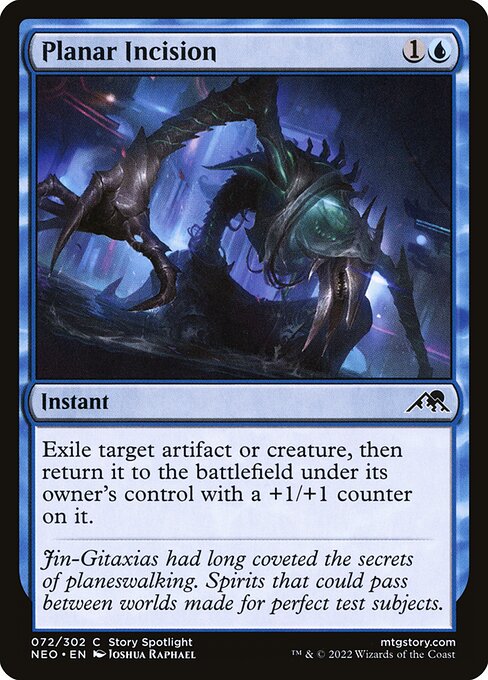
Image courtesy of Scryfall.com
A balancing mechanism told through Planar Incision
Storytelling in Magic: The Gathering isn’t just flavor text and epic battles; it’s a diagnostic tool for balance. The moment a new mechanic arrives, the story behind it helps players understand why certain plays feel fair and others feel unfair. Planar Incision embodies that narrative wisdom in a tiny, elegant package. With a humble {1}{U} mana cost, this common instant from Kamigawa: Neon Dynasty slips into a blue deck as a whisper of control and tempo—exile a troublesome artifact or creature, then return it to the battlefield under its owner’s control with a +1/+1 counter on it. It’s a micro-drama: you yank a threat into a pocket dimension, then drop it back with a surprising twist. 🧙♂️🔥
That twist matters in more than just tempo math. Exiling a mana rock or a stubborn attacker buys you crucial turns, especially in a game built on carefully choreographed exchanges. When Planar Incision returns the exiled permanent with a +1/+1 counter, the narrative isn’t simply “gone, then back.” It’s “delayed impact, stronger resolve.” The spell politely disrupts the flow, then reintroduces the threat with a new threat of its own—one that payloads the recipient with a signpost of resilience. It’s a reminder that in MTG, control can be a balancing force that preserves tension rather than eliminating it entirely. 💎⚔️
“Jin-Gitaxias had long coveted the secrets of planeswalking. Spirits that could pass between worlds made for perfect test subjects.”
That flavor text from Planar Incision isn’t mere atmosphere—it's a window into the card’s design philosophy. Neon Dynasty leans into a fusion of tradition and invention, where ancient schemata meet neon-lit streets. Planar Incision captures that spirit by linking a cerebral, counterplay-centered mechanic to a broader story about exploration, risk, and the costs of experimentation. The card’s art by Joshua Raphael, the neon-tinged aesthetic, and the subtle menace of exile all contribute to a cohesive storytelling experience that makes a single play feel like a chapter in a larger saga. 🎨🧭
Weaving lore into gameplay
When you study Planar Incision in a blue shell, you see how storytelling shapes decisions at the table. The exile-and-return motif is a perfect tool for controlling the tempo of a match. If your opponent has just committed a big threat, Planar Incision offers a surgical response: remove the immediate danger, then reintroduce it later with the added counterwork that makes the threat slightly more formidable than before—forcing your opponent to recalculate their plan. That recalibration creates emotional peaks in games, the very moments players remember after a night of tabletop battles. 🧙♂️🎲
In practical terms, Planar Incision shines in tempo and control archetypes. It’s perfectly legal in Modern, Legacy, Pioneer, and Commander formats, as well as Historic and other evergreen buckets. It discourages a single, runaway advantage by giving you a precise tool to answer both artifacts (think mana rocks orEquip-based threats) and creatures that have just crossed the line from nuisance to power spike. And because it returns the exiled permanent to its owner’s control, you’re not “stealing” a permanent for yourself—you’re briefly curating the board state, a storytelling device that adds narrative tension without breaking the game’s intrinsic balance. 🔥💎
Strategic ideas for Planar Incision in your decks
- Tempo and control shells: Use Planar Incision to trade resources efficiently. Silence a threatening blocker, then watch as your opponent contends with a re-entrant threat that’s now carrying a +1/+1 counter.
- Blink-friendly environments: Pair the card with enter-the-battlefield effects and flicker-enablers to maximize tempo swings, while keeping the target’s ownership intact—your opponent’s plans are temporarily derailed, not erased.
- Artifact-heavy boards: Blue decks that lean on artifacts can neutralize opposing ramp or powerful equipment for a single turn, giving you a window to stabilize or pivot into a win condition.
- Commander utility: In multiplayer formats, Planar Incision shines as a political tool—remove a shared threat now, and reintroduce it later with force, all while your board remains balanced and interactive.
- Counterplay-rich drafting and sealed: Even outside standard formats, the card’s timing and narrative impact shine in limited environments where every decision compounds into story moments worth retelling. ⚔️
The card’s blue identity (color identity: U) anchors this approach in a discipline that values information, timing, and precise control. It’s not about flashy overkills; it’s about shaping the arc of the game with thoughtful, story-forward decisions. The rarity is common, but the effect feels deliberately consequential—proof that small spells can carry big, narrative weight. And in Neon Dynasty’s era of swords and spirits, Planar Incision reminds us that the most gripping stories often hinge on the momentary disruption that becomes a turning point. 🧙♂️💥
Design, art, and value
Artwork in Kamigawa: Neon Dynasty leans into a kinetic blend of traditional Japanese aesthetics and futuristic glow. Planar Incision’s illustration emphasizes the precarious balance of exile and return, with the creature or artifact stepping back into play under its owner’s control like a character stepping out of a hidden door and back into the scene with renewed resolve. The card’s illustration ID, artist credit to Joshua Raphael, and neon palette capture the era’s vibe—a nod to fans who adore both flavorful storytelling and clean, readable design. The card’s market presence—the common foil or non-foil options and modest price points—makes Planar Incision accessible for casual decks and budget-conscious players while still delivering meaningful gameplay moments. 💎🎲
For collectors who chase the tactile thrill of physical cards, Planar Incision’s availability across formats makes it a sensible addition to a Neo-era collection. Its role in boards with shifting value—the way it temporarily removes a problem, then reintroduces it stronger—also mirrors how many players value narrative consistency in card design. The synergy between story and mechanics here is a quiet celebration of the balancing act that keeps MTG fresh, balanced, and endlessly re-readable. 🎨🧭
Neon Phone Case with Card Holder MagSafe – Impact ResistantMore from our network
- https://blog.crypto-articles.xyz/blog/post/control-fans-hope-to-see-next-for-new-powers-and-dlc/
- https://transparent-paper.shop/blog/post/why-digital-paper-is-transforming-journaling-communities/
- https://blog.digital-vault.xyz/blog/post/designing-visual-assets-that-clearly-communicate-value/
- https://blog.zero-static.xyz/blog/post/fighting-drake-tribal-crafting-synergy-in-drake-decks/
- https://crypto-acolytes.xyz/blog/post/best-minecraft-story-maps-for-immersive-adventures/